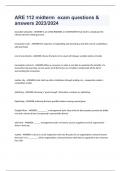ARE 112 midterm exam questions &
answers 2023/2024
bounded rationality - ANSWER-A set of BOUNDARIES or CONSTRAINTS that tend to complicate the
rational decision-making process
transaction costs - ANSWER-the expenses of negotiating and executing a deal (the cost of completing a
sale/purchase)
cost of uncertainty - ANSWER-chance that price of an asset will change; unstable stocks or bonds
incomplete contracts - ANSWER-When a consumer or seller is not able to maximize the benefits of a
transaction because they are not aware of all the factors or not able to understand all the factor
surrounding the transaction
mother city - ANSWER-Caral- Built up other civilizations through trading, etc.; cooperative model v
competitive model.
Satisficing - ANSWER-choosing a "good enough" alternative; compare w/ optimizing
Optimizing - ANSWER-achieving the best possible balance among several goals
Genghis Khan - ANSWER-_________'s management style: keep only the best people; promote by ability
not rank; mission-driven (as opposed to personality-driven)
wild west - ANSWER-______ management style: no history, success supplants survival, opportunity-
driven--start ups
market - ANSWER-a circus is run by ringmaster who sets the pace for an organization; everyone knows
their job; it is a ________- driven organization; everyone knows what they're supposed to do; everyone
has a job
,Classical Management - ANSWER-studies the way work is organized and the procedures used to
complete a job in order to increase worker productivity
Scientific Management, Taylorism - ANSWER-a management theory using efficiency experts to examine
each work operations and find ways to minimize the time needed to complete it; design jobs with
standards leading to efficiency; Select workers to fit the job design; Train works to follow the design; aka
______
Bureaucracy, Max Weber - ANSWER-logic, order, and legitimate authority; not based on social standing;
formal rules, impersonality; popularized by _______
administration - ANSWER-Henry Fayol popularized the idea of ______ of the firm; planning, organization,
command, coordination, control
Anthony's Management Hierarchy - ANSWER-strategic planning (executives), management control
(managers), operational control (supervisors), organizational members (workers)
Maslow's Hierarchy of Needs - ANSWER-physiological, safety, love/belonging, esteem, self-actualization
value proposition - ANSWER-In The Goal we saw Alex was on the operations side of the ______ and not
on the strategy side
Behavioral Management - ANSWER-Directed at organizational improvement through understanding
employee motivation and behavior.
Hawthorne Studies - ANSWER-introduced the human resources movement to the workplace.
X theory - ANSWER-This theory states that all employees are inherently lazy and must be motivated
Y theory - ANSWER-In this theory, the manager believes that employees are creative and willing to work
,Management Science - ANSWER-focuses on using mathematics to aid in problem solving and decision
making; introduction of TECHNOLOGY
structural system - ANSWER-formal designs, policies, procedures of organization; set force by
organization chart and includes division of work and patterns of authority; one of the sociotechnical
systems of organizational behavior
technical system - ANSWER-one of the socioetechnical systems of organizational behavior; devices, tools,
techniques needed to transform inputs into outputs in ways that enhance economic performance
psychosocial system - ANSWER-one of the sociotechnical systems of organizational behavior; social
relationships and behavioral patterns, norms roles and communications
goals and values subsystem - ANSWER-one of the sociotechnical systems of organizational behavior;
basic mission and vision of organization; profits, growth, survival; often influenced by larger environment
Sociotechnical Systems Theory - ANSWER-Theory that examines both social and technical characteristics
of tasks and how work is organized, focusing on the interaction between people and technologies
Short-wall and long-wall - ANSWER--example of MANAGEMENT SCIENCES approach
Long = one miner operates the machines which slices the coal and carries the coal back to the surface
Short = miners work in pairs or small groups to extract the coal
Macro problems - ANSWER-important, hard to solve
Micro problems - ANSWER-urgent, solutions right away
easy to solve/identify
young woman - ANSWER-the __________ case illustrated that beliefs do not equal values; beliefs are
personal while values are shared with others
, Driving forces - ANSWER-____________ for change: globalization, technology, competition, shift in
consumer demands, change in supply of raw material
targets - ANSWER-__________ for change: tasks, people, culture, technology, structure
MECE - ANSWER-Mutually Exclusive Collectively Exhaustive
mutually exclusive: is each issue a separate and distinct issue?
collectively exhaustive: does every aspect of the problem come under one, and only one, of the issues?
Consultant styles - ANSWER-pathfinder, persuader, analytical, cheerleader, stabilizer
Statistical Fluctuations - ANSWER-fluctuations in quantities that occur in a process and on a random
basis; unavoidable
substantive - ANSWER-________ conflict: involves disagreements over goals, resources, rewards,
policies, procedures, and job assignments
conflict - ANSWER-types of ________: substantive, emotional or relationship, functional, dysfunctional
Emotional or Relationship - ANSWER-________ conflict: disagreements among people and dynamics of
working together
functional - ANSWER-_______ conflict: focused on how and when a task will be performed
dysfunctional - ANSWER-_________ conflict: conflict that hinders the organization's performance or
threatens its interests




